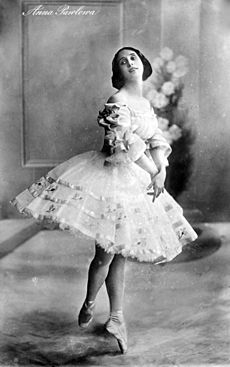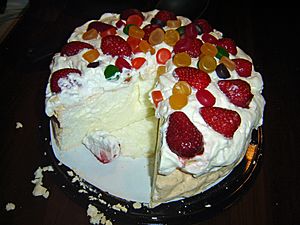Pavlova (dessert) facts for kids
| Course | Dessert |
|---|---|
| Main ingredients | Egg whites, caster sugar, fruit |
The Pavlova is a yummy dessert made mostly from meringue. It looks like a cake, with a crispy outside and a soft, light inside. People usually top it with fresh fruit and whipped cream.
This sweet treat was created in the early 1900s. It's named after a famous Russian ballerina called Anna Pavlova. Both Australia and New Zealand claim to have invented it!
Pavlova is a very popular dish in both Australia and New Zealand. It's often served during special celebrations and holidays, especially in the summer. This includes Christmas, which happens in summer in the Southern Hemisphere.
Contents
Where Did Pavlova Come From?

People believe the pavlova was made to honor Anna Pavlova. This happened during or after her tours to Australia and New Zealand in the 1920s. For many years, these two countries have argued about who created it first.
Some early recipes for similar dishes were found in Australia from 1906. But these were called 'cream cakes' and not 'pavlova' yet. In 1911, a recipe for "Strawberries Pavlova" appeared in New Zealand. However, this was for an ice block or sorbet, not the meringue dessert we know today.
The first known recipe that looked like the modern pavlova was in an Australian cookbook from 1922. It was called "Meringue with Fruit Filling." The name 'Pavlova' first appeared in an Australian recipe in 1926. But this was for a jelly dessert, not the meringue one.
A recipe for 'pavlova cake' from New Zealand was found in 1929. Another one was published in a New Zealand newspaper in 1934.
Some people claim that Bert Sachse created the dish in Perth, Australia, in 1935. However, researchers say that similar recipes were already appearing in cookbooks by the 1940s in Australia.
Other experts think pavlova might have come from outside Australia and New Zealand. They found that similar desserts existed in Europe, like the Austro-Hungarian Spanische windtorte. These desserts, made with meringue, whipped cream, and fruit, came to the United States. American cornstarch packages with meringue recipes were then sent to New Zealand in the 1890s.
It's hard to say for sure where pavlova truly began. Many researchers believe it was a "social invention." This means different cooks in both countries shared ideas and made similar desserts. Over time, people gave it the name 'pavlova' and created stories about its origin.
How to Make and Enjoy Pavlova

Making pavlova is similar to making meringue. First, egg whites are beaten until they are very stiff. Then, caster sugar is slowly added. After that, a little vinegar or lemon juice, cornflour, and vanilla are gently mixed in.
The meringue mixture is shaped into a round cake on baking paper. It usually has a slightly lower center. Then, it's baked in a cool oven (around 120-150°C) for about 45 to 60 minutes. After baking, it's left in the oven to cool down and dry out, often overnight.
What makes pavlova special is its texture. It has a crunchy shell on the outside. But inside, it's soft and feels like a marshmallow. This is different from regular meringue, which is usually solid all the way through. Many believe the cornflour helps create this soft center.
Pavlova is traditionally topped with whipped cream and fresh, soft fruits. Popular choices include kiwifruit, passionfruit, and strawberries. You can buy ready-made pavlova shells at supermarkets. Then, you can decorate them however you like!
If you have leftover pavlova that's already decorated, you can keep it in the fridge overnight. However, it might lose some of its crispiness. An undecorated pavlova can stay fresh for several days in an airtight container. You can then decorate it just before serving.
Pavlova in Culture
Pavlova is a very popular dessert on Christmas Day in Australia and New Zealand. Since Christmas happens during the summer there, people often serve pavlova chilled from the fridge.
World's Biggest Pavlovas
People love to make giant pavlovas!
- In February 1999, the Te Papa museum in New Zealand made a huge pavlova called "Pavzilla." It was 45 meters long!
- Students in New Zealand broke this record in March 2005. Their pavlova, named "Pavkong," was 64 meters long.
- In 2010, a chef in New Zealand made a 50-square-meter pavlova shaped like a rugby field. It helped raise money for charity.
- In May 2018, a Norwegian chef and 35 helpers created an even bigger pavlova. It measured an amazing 85 square meters!
See also
 In Spanish: Pavlova (postre) para niños
In Spanish: Pavlova (postre) para niños


